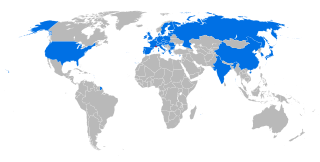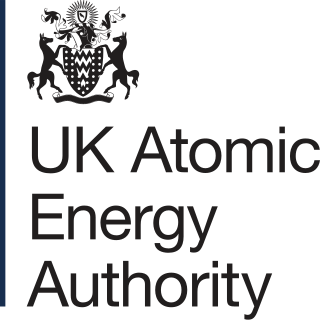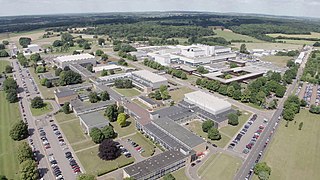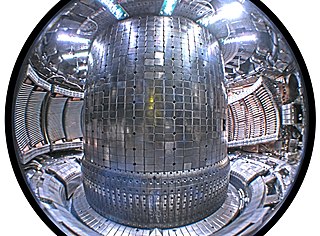
A tokamak is a device which uses a powerful magnetic field generated by external magnets to confine plasma in the shape of an axially-symmetrical torus. The tokamak is one of several types of magnetic confinement devices being developed to produce controlled thermonuclear fusion power. The tokamak concept is currently one of the leading candidates for a practical fusion reactor.

Fusion power is a proposed form of power generation that would generate electricity by using heat from nuclear fusion reactions. In a fusion process, two lighter atomic nuclei combine to form a heavier nucleus, while releasing energy. Devices designed to harness this energy are known as fusion reactors. Research into fusion reactors began in the 1940s, but as of 2024, no device has reached net power, although net positive reactions have been achieved.
This timeline of nuclear fusion is an incomplete chronological summary of significant events in the study and use of nuclear fusion.
The European School, Culham (ESC) was one of the fourteen European Schools and the only one in the United Kingdom. Located in Culham near Abingdon in Oxfordshire. It was founded in 1978 for the purpose of providing an education to the children of staff working for the European Atomic Energy Community (Euratom).

The European Atomic Energy Community is an international organisation established by the Euratom Treaty on 25 March 1957 with the original purpose of creating a specialist market for nuclear power in Europe, by developing nuclear energy and distributing it to its member states while selling the surplus to non-member states. However, over the years its scope has been considerably increased to cover a large variety of areas associated with nuclear power and ionising radiation as diverse as safeguarding of nuclear materials, radiation protection and construction of the International Fusion Reactor ITER.

The Joint European Torus (JET) was a magnetically confined plasma physics experiment, located at Culham Centre for Fusion Energy in Oxfordshire, UK. Based on a tokamak design, the fusion research facility was a joint European project with the main purpose of opening the way to future nuclear fusion grid energy. At the time of its design JET was larger than any comparable machine.

ITER is an international nuclear fusion research and engineering megaproject aimed at creating energy through a fusion process similar to that of the Sun. Upon completion of construction of the main reactor and first plasma, planned for late 2025, it will be the world's largest magnetic confinement plasma physics experiment and the largest experimental tokamak nuclear fusion reactor. It is being built next to the Cadarache facility in southern France. ITER will be the largest of more than 100 fusion reactors built since the 1950s, with ten times the plasma volume of any other tokamak operating today.

The Nuclear Energy Agency (NEA) is an intergovernmental agency that is organized under the Organisation for Economic Co-operation and Development (OECD). Originally formed on 1 February 1958 with the name European Nuclear Energy Agency (ENEA)—the United States participated as an Associate Member—the name was changed on 20 April 1972 to its current name after Japan became a member.

The United Kingdom Atomic Energy Authority is a UK government research organisation responsible for the development of fusion energy. It is an executive non-departmental public body of the Department for Energy Security and Net Zero (DESNZ).
JT-60 is a large research tokamak, the flagship of the Japanese National Institute for Quantum Science and Technology's fusion energy directorate. As of 2023 the device is known as JT-60SA and is the largest operational superconducting tokamak in the world, built and operated jointly by the European Union and Japan in Naka, Ibaraki Prefecture. SA stands for super advanced tokamak, including a D-shaped plasma cross-section, superconducting coils, and active feedback control.

Cadarache is the largest technological research and development centre for energy in Europe. It includes the CEA research activities and ITER. CEA Cadarache is one of the 10 research centres of the French Commission of Atomic and Alternative Energies.

DEMO, or a demonstration power plant, refers to a proposed class of nuclear fusion experimental reactors that are intended to demonstrate the net production of electric power from nuclear fusion. Most of the ITER partners have plans for their own DEMO-class reactors. With the possible exception of the EU and Japan, there are no plans for international collaboration as there was with ITER.
EFDA has been followed by EUROfusion, which is a consortium of national fusion research institutes located in the European Union and Switzerland.
Ignitor is the Italian name for a planned tokamak device, developed by ENEA. As of 2022, the device has not been constructed.

The Culham Centre for Fusion Energy (CCFE) is the UK's national laboratory for fusion research. It is located at the Culham Science Centre, near Culham, Oxfordshire, and is the site of the Joint European Torus (JET), Mega Ampere Spherical Tokamak (MAST) and the now closed Small Tight Aspect Ratio Tokamak (START).

In nuclear fusion power research, the plasma-facing material (PFM) is any material used to construct the plasma-facing components (PFC), those components exposed to the plasma within which nuclear fusion occurs, and particularly the material used for the lining the first wall or divertor region of the reactor vessel.
EUROfusion is a consortium of national fusion research institutes located in the European Union, the UK, Switzerland and Ukraine. It was established in 2014 to succeed the European Fusion Development Agreement (EFDA) as the umbrella organisation of Europe's fusion research laboratories. The consortium is currently funded by the Euratom Horizon 2020 programme.
Spherical Tokamak for Energy Production (STEP) is a spherical tokamak fusion plant concept proposed by the United Kingdom Atomic Energy Authority (UKAEA) and funded by UK government. The project is a proposed DEMO-class successor device to the ITER tokamak proof-of-concept of a fusion plant, the most advanced tokamak fusion reactor to date, which is scheduled to achieve a 'burning plasma' in 2035. STEP aims to produce net electricity from fusion on a timescale of 2040. Jacob Rees-Mogg, the UK Secretary of State for Business, Energy and Industrial Strategy, announced West Burton A power station in Nottinghamshire as its site on 3 October 2022 during the Conservative Party Conference. A coal-fired power station at the site ceased production a few days earlier. The reactor is planned to have a 100 MW electrical output and be tritium self-sufficient via fuel breeding.

The European Schools is an intergovernmental organisation, which has established, financed, and administered a small group of multilingual international schools, bearing the title "European School", which exist primarily to offer an education to the children of European Union (EU) staff; offers accreditation to other schools, bearing the title "Accredited European School", under national jurisdiction within EU member states to provide its curriculum; and oversees the provision of the secondary school leaving diploma, the European Baccalaureate.
Donato Palumbo was an Italian physicist best known as the leader of the European Atomic Energy Community (Euratom) fusion research program from its formation in 1958 to his retirement in 1986. He was a key force in the development of the tokamak during the 1970s and 80s, contributing several papers on plasma confinement in these devices and leading the JET fusion reactor program, which as of 2021, retains the record for the closest approach to breakeven, the ratio between the produced fusion power and the power used to heat it. He is referred to as the founding father of the European fusion program.













